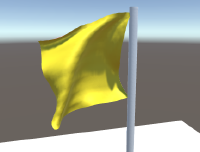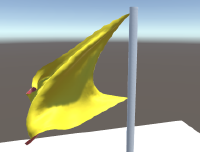Tether Constraints 
Tether constraints are very similar in nature to distance constraints, however they are designed with one very specific goal in mind: to reduce overstretching in long chains of distance constraints.
Because of the iterative nature of Obi's solver, constraints potentially need an infinite amount of iterations to converge. In long chains of constraints, this means that the individual error of each constraint accumulates troughout the whole chain and the final error can be very noticeable, specially when some particles in the chain are fixed. When tether constraints are introduced between fixed and free particles, they force free particles to stay under a certain distance from their nearest fixed particle(s).
These constraints are automatically generated by clicking the Generate Tether Constraints button in their inspector. You should always regenerate the tethers after you´ve fixed/unfixed particles in your actor. This way the tethers setup is guaranteed to be optimal.

Tether scale
Scales the initial length of tethers. Values > 1 will extend the tethers, while values < 1 will shorten them.



From left to right: flag with tether scale of 1, 1.2 and 2. As you can see, longer tethers allow free particles to separate more from the two fixed particles at the corners of the flag that keep it tied to the post. This causes the flag to look stretchy like it would with no tethers at all.
Stiffness
Similarly as with other constraint types, this controls how aggresive tether constraints are.